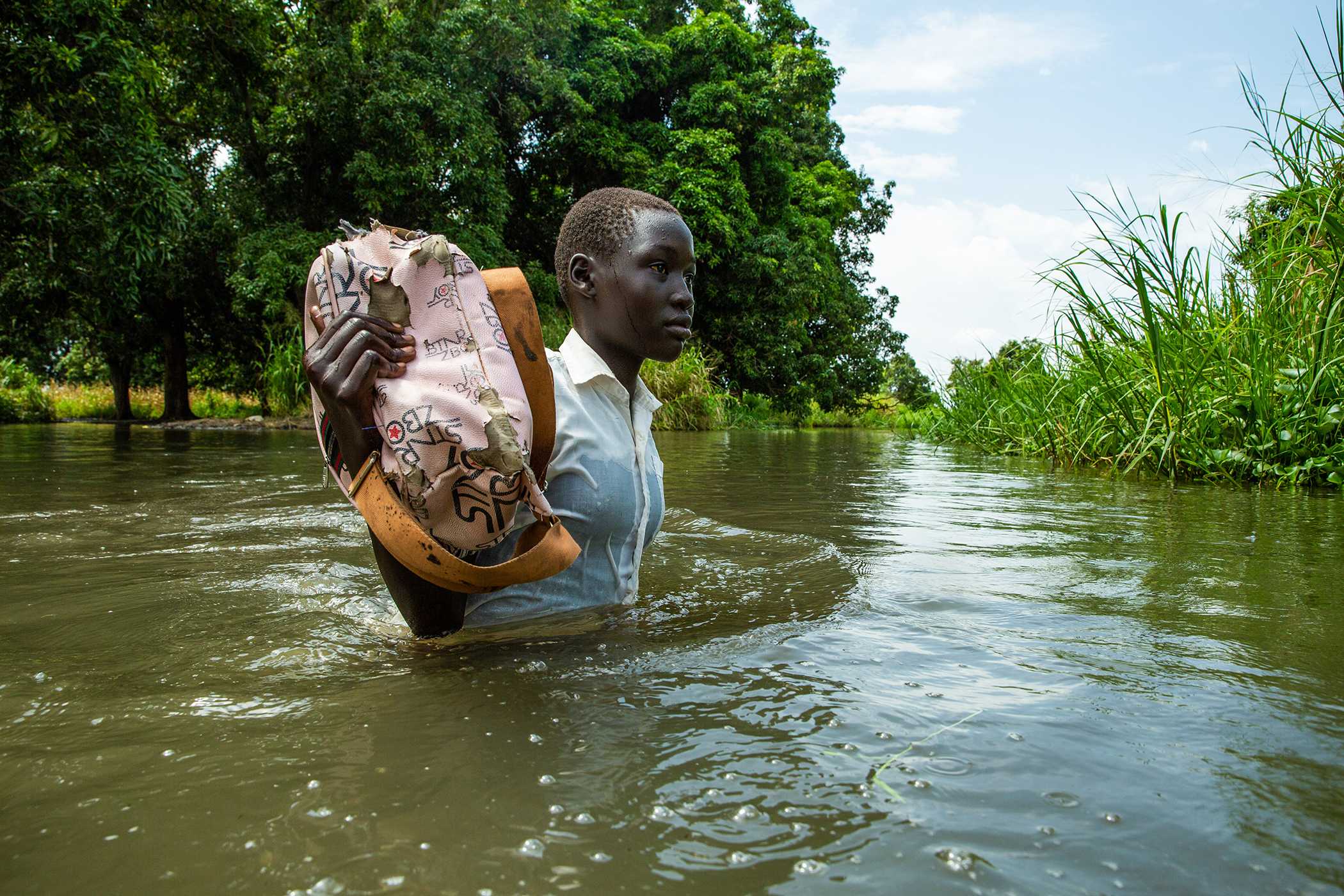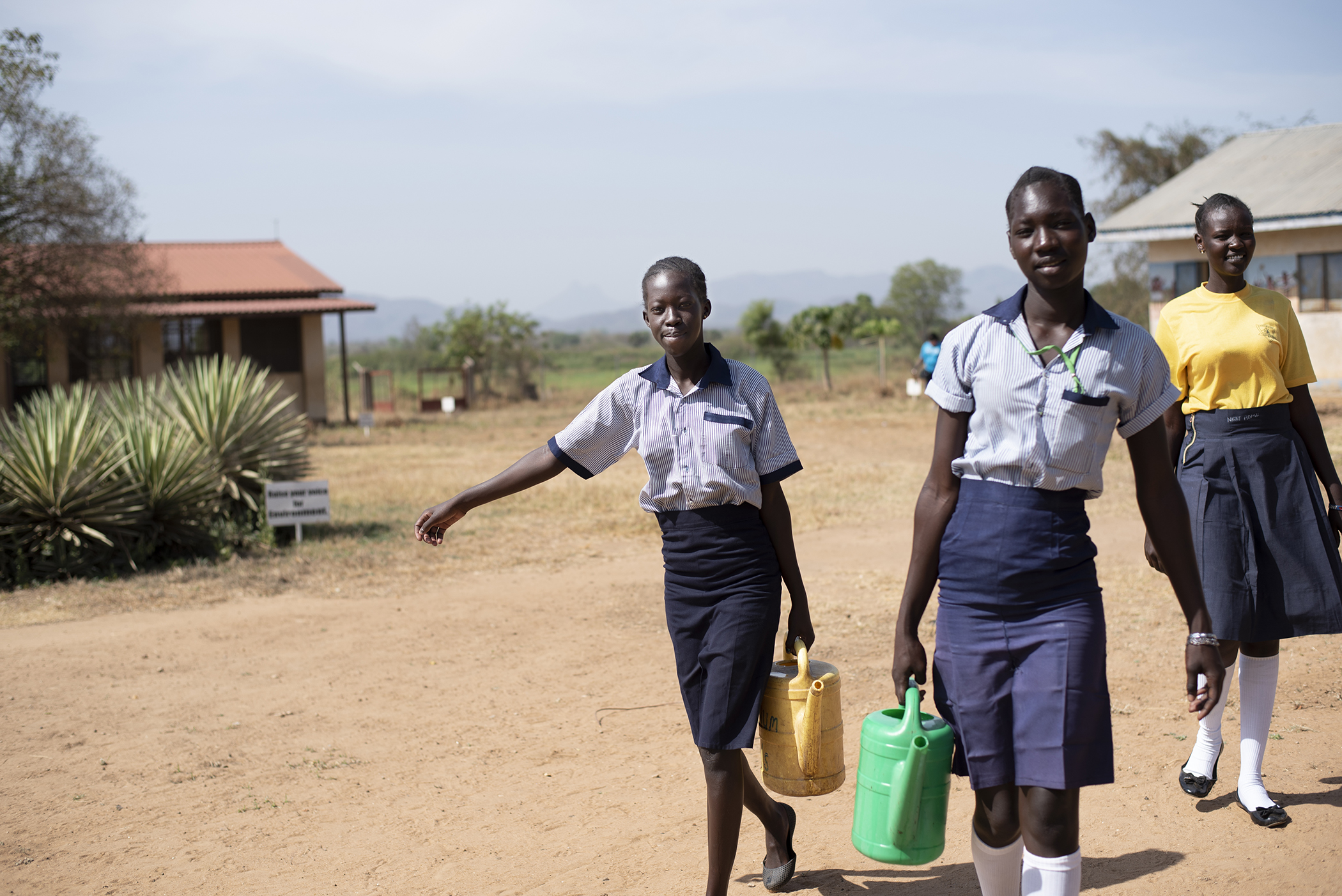For girls living in poverty around the world, getting an education means putting their safety and well-being at risk on a daily basis.
The COVID-19 pandemic disrupted education for 1.4 billion children, but the public health crisis disproportionately impacted marginalized girls who were already vulnerable to falling behind.
The costs of education, from tuition to school fees, are too high as many families barely scrape by. Having a daughter work or handle the household chores instead of sending them to school is often the more affordable option, especially in the wake of economic shocks.
The pandemic has also exacerbated the digital divide, and emerging data suggest gender-based violence is increasing, UNICEF Director of Education Robert Jenkins told Global Citizen.
“Girls disproportionately had less access to a device due to gender barriers, but also now that schools are reopening, they're more likely to live in a community where the school is not able to meet their needs,” Jenkins said.
UNICEF and organizations like Education Cannot Wait (ECW) are working to keep girls in school under difficult circumstances.
Lockdown restrictions not only stunted children academically –– more girls were trapped at home with their abusers with limited access to life-saving information and services. Harmful practices such as child marriage and female genital mutilation (FGM) have been on the rise due to lack of access to support usually provided by schools or community networks.
The longer girls have been out of school, the less likely they might be to want to return, and early marriage becomes the only alternative. Even girls who fight for their right to pursue education instead of entering a forced marriage, or refuse to undergo practices FGM, are subject to further punishment and rejection from their families and communities.
“I'd rather throw myself in the water or burn myself, but definitely not getting married.”
In 2014, the extremist group Boko Haram, which was responsible for kidnapping thousands of people and taking girls out of school in an attempt to build an Islamic state, abducted 276 schoolgirls from Chibok in Nigeria’s Borno State.
Yakoura Yande El H Madou, 15, fled her Nigerian village with her family for Diffa, Niger, to escape the threat of Boko Haram.
“One day my mother told me that it’s time for me to marry. She told me there was a man in the family who was ready to marry me,” Madou told UNICEF. “But I didn't want to get married at all. I was sure. I'd rather throw myself in the water or burn myself, but definitely not getting married.”
Madou’s father beat her, and her mother verbally abused her for protesting, but she did not let up. The abuse continued, even after the members of the protection center came to speak with her parents several times over the course of five months about the dangers of child marriage.
A legal threat finally eased the tension, and now Madou balances school with working for her mother while continuing to advocate to stop child marriage within her community.
 Yakoura Yande El H Madou is 15 years old in Diffa, in the extreme southeast of Niger.
Yakoura Yande El H Madou is 15 years old in Diffa, in the extreme southeast of Niger.
Meanwhile, in Afghanistan, the Taliban –– a Sunni Islamist militant group that believes educating women goes against Islam –– took over in August 2021 for the first time since 2001 and has inconsistently closed down schools as part of an effort to strip away women’s hard-earned freedoms over the past 20 years.
At a UNICEF-supported community-based school in the Kandahar’s Dand district, courageous girls who otherwise would not attend class in other locations subject to violent attacks are able to go to school. Girls and women in conflict and crisis-affected areas encounter more obstacles to attending school, and girls' schools are three times as likely to be attacked than boys' schools.
Less than a third of provinces in Afghanistan have allowed girls’ schools to reopen, and even fewer have resumed secondary classes.
 Girls attend classes at a UNICEF-supported community based school in Kandahar’s Dand district on Feb. 24, 2022.
Girls attend classes at a UNICEF-supported community based school in Kandahar’s Dand district on Feb. 24, 2022.
“Girls in Afghanistan not only face challenges in returning to school, but the collapse of the economy, and the financial pressure from their parents and themselves,” Jenkins said.
When Jenkins visited Afghanistan in fall 2021, he saw the innovative spaces where girls are attending makeshift schools.
“There are community-based schools, some actually in people's homes,” he said. “They've allocated a room in their home for learning, and they have learning materials on the walls.”
“Socially and practically, getting every young mother to return to school is difficult."
However, when schools do reopen after disruption, challenges for girls remain.
In countries across sub-Saharan Africa, girls have been banned from attending school due to early pregnancies, Jenkins explained.
“We still have significant numbers of countries that have such a policy in place, something we're advocating to change, but also socially and practically, getting every young mother to return to school is difficult, even if there isn't a policy that prevents them,” he said.
In Uganda, where schools only re-opened for the first time in January 2022 after a two-year COVID-19 closure, Jane, a teenager who chose not to reveal her real name, was raped at 14 and didn’t tell anyone due to fear of retaliation. After Jane learned she was pregnant and had her baby, rather than perpetuating stigma and shame, with support from UNICEF she started a grocery business, kept going to school, and chose to speak openly about her experience to create more awareness.
In addition to dealing with social norms and pressures, young mothers also have to navigate the logistics of child care, Jenkins explained.
The risks girls living in poverty face when trying to get an education are compounded if she has disabilities. Children with disabilities are less likely, on average, to go to school and, when they do, they are less likely to finish. Barriers to school enrollment and retention include lack of accessible infrastructure and materials, lack of adaptive or inclusive teaching practices, discrimination, and abuse.
Achol Mary was born with a disability that affected her ability to walk, forcing her to get around on her knees or use a walking stick to stand while growing up in South Sudan. Mary’s family often left her home alone, and she could not play with other children.
ECW provided Mary with a wheelchair in 2020 as part of funding for assistive devices from the organization’s Multi-Year Resilience Program.
“From that moment, my heart was filled with joy,” Mary said of receiving a wheelchair.
 Celebrations around International Day of Persons with Disabilities takes place in Warrap State, South Sudan in 2021.
Celebrations around International Day of Persons with Disabilities takes place in Warrap State, South Sudan in 2021.
While Mary’s wheelchair opened up access to education and health, she still has to navigate lack of access for people with disabilities in South Sudan. During the rainy season, for example, roads are impossible to navigate due to flooding and mud.
Extreme weather patterns and flooding are only expected to increase due to climate change, complicating water collection, and dangerous commutes for girls. Girls spend 200 million hours a day walking long distances to collect water, time that could be spent in school and that puts them at risk of sexual abuse and disease.
At one school in South Sudan, Margaret Ika, 17, said she had to walk over a mile home and back to get water during the school day because her school cannot maintain a steady supply.
Other girls in South Sudan were forced to walk through waist-level flooding from the Nile River in October 2021.
"She was stained with blood. Some refused to take the mat where the girl had sat.”
For many families, another obstacle standing in the way of their daughters’ education is menstrual hygiene management (MHM). Sending sons to school is seen as more cost effective because period products are too expensive. Girls without the resources to manage their period end up experiencing public shame, missing class, dropping out of school, and they are more vulnerable to sexual violence.
 Souhadi instructs a student during classin Bagasola, Chad. ECW has supported Jesuit Refugee Service (JRS) Chad in producing menstrual hygiene kits to help keep girls in school across Chad’s Lake Chad and Logone Oriental regions.
Souhadi instructs a student during classin Bagasola, Chad. ECW has supported Jesuit Refugee Service (JRS) Chad in producing menstrual hygiene kits to help keep girls in school across Chad’s Lake Chad and Logone Oriental regions.
ECW has supported Jesuit Refugee Service (JRS) Chad in producing menstrual hygiene kits to help keep girls in school across Chad’s Lake Chad and Logone Oriental regions. Before receiving the kits, a teacher who goes by Souhadi recalled witnessing the stigma of a student who couldn’t manage her period.
“There was a girl in the classroom, sitting on the mat,” Souhadi told JRS and ECW. “When she stood up, her classmates noticed she was stained with blood. Some refused to take the mat where the girl had sat.
"She was ashamed, sitting down, and didn’t want to get back up,” Souhadi continued. “We [the teachers] finally convinced her not to stay at home but to go to school. We washed the mat ourselves. The next day, the girl came to school, as she had promised, and she has been coming very regularly to this day.”
One student pointed out that even with menstrual hygiene products, other factors continue to threaten girls’ safety in the classroom.
"To improve girls’ MHM at school, it would be necessary to improve the current latrines, since there is no door and other children can see us,” Kaikai, a 14-year-old student in Chad, told JRS and ECW. “We are forced to hide in the bush to change the sanitary pads.” Kaikai, member of the Gilrs Club at Dibina School, received a MHM kit through her class in Bagasola, Chad.
Kaikai, member of the Gilrs Club at Dibina School, received a MHM kit through her class in Bagasola, Chad.
Girls’ education is essential to sustainability and growth within all countries and communities.
Although individual girls are defying the odds against them to receive an education, international support is crucial for initiatives and programs that enable all girls and their communities to thrive.
Everyday citizens getting engaged, informed, and advocating for education within their own communities to address the barriers to girls’ education is essential to sustainability and growth within all countries and communities, Jenkins explained.
“There is a direct correlation with those countries that provide opportunities for girls and adolescent girls with the strength of their economies, positive social change, and long-term improvement,” he said.

